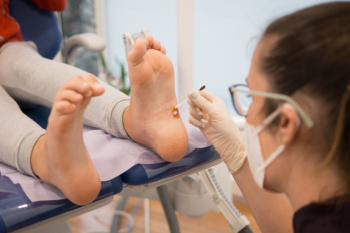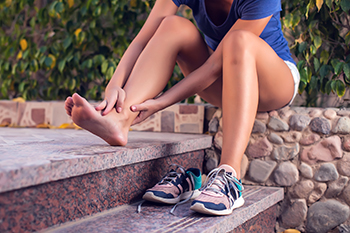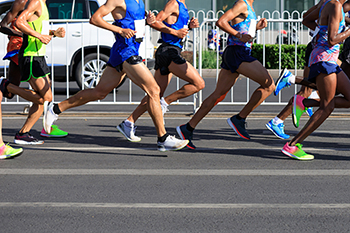Items filtered by date: September 2024
Symptoms and Treatment of Plantar Warts

Plantar warts, caused by the human papillomavirus, or HPV, often develop on the soles of the feet, leading to discomfort, especially while walking. Highly contagious plantar warts typically appear as firm, rough, and flat lesions, often with small black dots at the center. They commonly affect people who use communal showers, pools, or changing areas. While plantar warts can affect anyone, people with a weakened immune system are particularly vulnerable. Diagnosis of plantar warts is generally made through visual examination to differentiate the wart from similar skin conditions, like corns or calluses. Treatment provided by a podiatrist may include cryotherapy, where the wart is frozen off, or the application of topical salicylic acid to dissolve the wart over time. A podiatrist can also offer more advanced options if the wart resists initial treatment. If you have developed a plantar wart, it is suggested that you schedule an appointment with a podiatrist for a diagnosis and treatment.
Plantar warts can be very uncomfortable. If you need your feet checked, contact one of our podiatrists from CyFair Family Foot Care. Our doctors will assist you with all of your foot and ankle needs.
About Plantar Warts
Plantar warts are the result of HPV, or human papillomavirus, getting into open wounds on the feet. They are mostly found on the heels or balls of the feet.
While plantar warts are generally harmless, those experiencing excessive pain or those suffering from diabetes or a compromised immune system require immediate medical care. Plantar warts are easily diagnosed, usually through scraping off a bit of rough skin or by getting a biopsy.
Symptoms
- Lesions on the bottom of your feet, usually rough and grainy
- Hard or thick callused spots
- Wart seeds, which are small clotted blood vessels that look like little black spots
- Pain, discomfort, or tenderness of your feet when walking or standing
Treatment
- Freezing
- Electric tool removal
- Laser Treatment
- Topical Creams (prescription only)
- Over-the-counter medications
To help prevent developing plantar warts, avoid walking barefoot over abrasive surfaces that can cause cuts or wounds for HPV to get into. Avoiding direct contact with other warts, as well as not picking or rubbing existing warts, can help prevent the further spread of plantar warts. However, if you think you have developed plantar warts, speak to your podiatrist. He or she can diagnose the warts on your feet and recommend the appropriate treatment options.
If you have any questions please feel free to contact our offices located in Cypress and Spring, TX . We offer the newest diagnostic and treatment technologies for all your foot and ankle needs.
Locations and Causes of Ankle Pain

Ankle pain can come from different parts of the ankle, including bones, ligaments, muscles, nerves, and tendons. One common cause is a sprain in a ligament on the outside of the ankle, called the anterior talofibular ligament, which can get overstretched or torn if you twist your ankle suddenly. Pain on the inside of the ankle might be due to an injury to the deltoid ligament, which helps support the inner side of the ankle, and this can happen if you twist your ankle inwards or suffer a blow. Pain higher up on the ankle, near where the shin bones meet, can occur if the ligaments that hold those bones together are injured, often from a severe twisting motion. Muscles in the ankle can also get strained from overuse, and nerves can become painful due to conditions like tarsal tunnel syndrome, which is similar to carpal tunnel in the wrist. Injuries to tendons, like the Achilles tendon at the back of the ankle, can also cause significant pain. If you have ankle pain, it is suggested that you make an appointment with a podiatrist for an exam, diagnosis, and treatment.
Ankle pain can be caused by a number of problems and may be potentially serious. If you have ankle pain, consult with one of our podiatrists from CyFair Family Foot Care. Our doctors will assess your condition and provide you with quality foot and ankle treatment.
Ankle pain is any condition that causes pain in the ankle. Due to the fact that the ankle consists of tendons, muscles, bones, and ligaments, ankle pain can come from a number of different conditions.
Causes
The most common causes of ankle pain include:
- Types of arthritis (rheumatoid, osteoarthritis, and gout)
- Ankle sprains
- Broken ankles
- Achilles tendonitis
- Achilles tendon rupture
- Stress fractures
- Bursitis
- Tarsal tunnel syndrome
- Plantar fasciitis
Symptoms
Symptoms of ankle injury vary based upon the condition. Pain may include general pain and discomfort, swelling, aching, redness, bruising, burning or stabbing sensations, and/or loss of sensation.
Diagnosis
Due to the wide variety of potential causes of ankle pain, podiatrists will utilize a number of different methods to properly diagnose ankle pain. This can include asking for personal and family medical histories and of any recent injuries. Further diagnosis may include sensation tests, a physical examination, and potentially x-rays or other imaging tests.
Treatment
Just as the range of causes varies widely, so do treatments. Some more common treatments are rest, ice packs, keeping pressure off the foot, orthotics and braces, medication for inflammation and pain, and surgery.
If you have any questions, please feel free to contact our offices located in Cypress and Spring, TX . We offer the newest diagnostic and treatment technologies for all your foot care needs.
Gait Retraining in Distance Runners

Gait retraining is an increasingly popular intervention for distance runners experiencing pain or injury due to improper running mechanics. This specialized training focuses on altering a runner’s movement patterns to reduce stress on tissues and redistribute forces more evenly across joints. Common techniques include visual feedback, step rate manipulation, and foot strike adjustments. Each method of gait retraining aims to correct specific biomechanical issues that contribute to running-related injuries. While gait retraining has proved effective, it is essential to tailor the approach to the individual’s needs and abilities. A podiatrist can help a runner make an informed decision about which gait retraining methods will be most beneficial. Given the complexity of running mechanics, a thorough evaluation by a podiatrist ensures that the method chosen will address the root cause of pain without introducing new issues. If you experience foot pain after long distance running, it is suggested that you schedule an appointment with a podiatrist to determine if gait retraining is needed.
If you have any concerns about your feet, contact one of our podiatrists from CyFair Family Foot Care. Our doctors can provide the care you need to keep you pain-free and on your feet.
Biomechanics in Podiatry
Podiatric biomechanics is a particular sector of specialty podiatry with licensed practitioners who are trained to diagnose and treat conditions affecting the foot, ankle and lower leg. Biomechanics deals with the forces that act against the body, causing an interference with the biological structures. It focuses on the movement of the ankle, the foot and the forces that interact with them.
A History of Biomechanics
- Biomechanics dates back to the BC era in Egypt where evidence of professional foot care has been recorded.
- In 1974, biomechanics gained a higher profile from the studies of Merton Root, who claimed that by changing or controlling the forces between the ankle and the foot, corrections or conditions could be implemented to gain strength and coordination in the area.
Modern technological improvements are based on past theories and therapeutic processes that provide a better understanding of podiatric concepts for biomechanics. Computers can provide accurate information about the forces and patterns of the feet and lower legs.
Understanding biomechanics of the feet can help improve and eliminate pain, stopping further stress to the foot.
If you have any questions please feel free to contact our offices located in Cypress and Spring, TX . We offer the newest diagnostic and treatment technologies for all your foot and ankle needs.
Blisters from Wearing High Heels

Wearing high heels can often lead to painful blisters on the feet. These blisters form due to excessive friction and pressure against the skin, which causes the outer layer to separate from the deeper layers. As a result, fluid accumulates in the space, forming a blister. High heels typically increase the likelihood of blisters because they alter the natural alignment of the foot and place pressure on areas that are not accustomed to such strain. To relieve and prevent blisters, opt for well-fitting, cushioned shoes that reduce friction. It is also helpful to give your feet regular breaks from high heels and to practice proper foot care, including moisturizing and keeping the skin healthy to reduce the risk of blisters. Blisters can be bothersome and may become infected. If you frequently develop blisters from wearing high heels, it is suggested that you contact a podiatrist who can offer effective relief and prevention techniques.
Blisters may appear as a single bubble or in a cluster. They can cause a lot of pain and may be filled with pus, blood, or watery serum. If your feet are hurting, contact one of our podiatrists of CyFair Family Foot Care. Our doctors can provide the care you need to keep you pain-free and on your feet.
Foot Blisters
Foot blisters are often the result of friction. This happens due to the constant rubbing from shoes, which can lead to pain.
What Are Foot Blisters?
A foot blister is a small fluid-filled pocket that forms on the upper-most layer of the skin. Blisters are filled with clear fluid and can lead to blood drainage or pus if the area becomes infected.
Symptoms
(Blister symptoms may vary depending on what is causing them)
- Bubble of skin filled with fluid
- Redness
- Moderate to severe pain
- Itching
Prevention & Treatment
In order to prevent blisters, you should be sure to wear comfortable shoes with socks that cushion your feet and absorb sweat. Breaking a blister open may increase your chances of developing an infection. However, if your blister breaks, you should wash the area with soap and water immediately and then apply a bandage to the affected area. If your blisters cause severe pain it is important that you call your podiatrist right away.
If you have any questions, please feel free to contact our offices located in Cypress and Spring, TX . We offer the newest diagnostic and treatment technologies for all your foot care needs.
